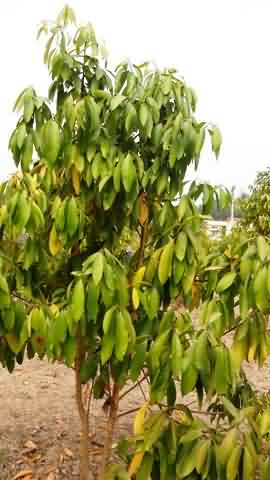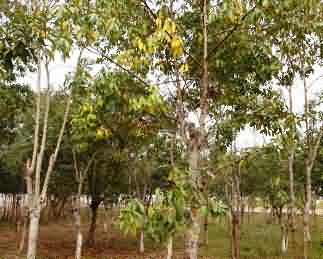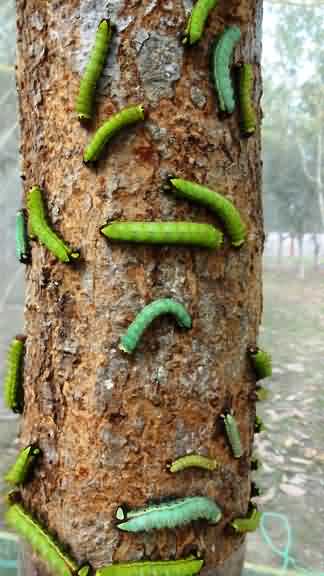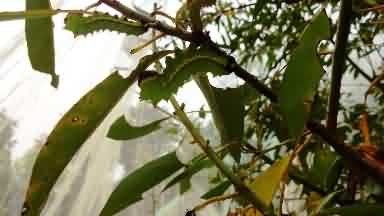मूगा रेशम के कीट के बारहमासी मेजबान वृक्ष, सोम (पर्सिया बॉम्ब्सीना) की खेती की तकनीक।
Muga silkworm Antheraea assamensis Helfer, is a sericigenous insect secreting a golden yellow coloured lustrous silk. This unusual colour and strong nature of the thread produced from the cocoon of this silkworm are the two important features for which this silkworm is termed unique.
Muga silkworm is multivoltine in nature, with six broods per year, including two crops each of pre-seed, seed and commercial. ‘Chotua’ (reared during March-April) and ‘Bhodia’ (reared during August-September) are seed crops, ‘Jethua’ (May-June) and ‘Kotia’ (October-November) are commercial crop while ‘Jarua’ (December-January) and ‘Aherua’ (June-July) are pre seed crops.
Jethua and Kotia are the only crops used for commercial production while the rest of the crops are meant only for obtaining seeds for supplying and continuing rearing in favorable seasons. Antherea assama is confined to only Brahmaputra Valley of India in the world.
The Primary Host plant of Muga silkworm is Som (Persea bombycina) and Soalu (Litsea polyantha). Accounting to the State Sericulture Department, the State has produced 114.56 MT Muga Raw Silk, during the year 2011-12 as against 113.28 MT Muga Raw Silk, produced in the State during the year 2010-11. (http://databank.nedfi.com/content/sericulture-assam)
Som Cultivation
Propagation:-
Som (Persea bombycina) is commonly propagated from seeds. Systematic plantation of muga host plant is a primary need for enhancing production and productivity of muga raw silk. It is desirable to collect the seeds from the healthy plants for growing of seedlings. Som seeds are initially sown in nursery beds or in poly bags and transplanted later to the field for raising systematic plantation.


सोम वृक्ष Som Plantation
Nursery Techniques:-
- Select high and shady land free from water logging.
- Plough the land at least up to 30 cm depth and level properly.Make seed beds of 5m x 1m in size with 10-15 cm high.
- Maintain a gap of 30 cm between two seed beds for cultural operation as well as for drainage.
- Apply 50 kg compost and 200g. 10% BHC powder in each bed and mix with the soil properly.
- Collect mature and ripe seeds from the Som plants during the month of April-May.
- Wash the seeds thoroughly in running water to remove the pulp completely.
- Seeds that submerge and gather at the bottom of the container during washing should be collected and allowed to dry in shady place.
- Generally, seeds with 3.0 g. in weight and 7.0 mm in diameter are to be selected for sowing
- Mix 2.0 g. ceresin powder with 1 kg. Seed to prevent fungal infestation.
- Sow the seeds in ready nursery beds within a week.
- Sow maximum 8000 seeds per bed at a depth of 1 cm and 15 cm apart between the two seeds for proper germination.
- After sowing, mulch the seed bed with a thin layer of thatch or dry hay.
- Seeds can also be sown directly at polythene tube filled with a mixture of sand, soil and FYM (1:1:1)
- Water the seed beds at regular intervals for timely germination.
- Germination will take place within 40-60 days in Som seeds.
- Remove weeds from the nursery beds at regular intervals for healthy growth of seedlings.
Maintenance of Som plant Nursery bed:-
- For proper and healthy growth, transplant 2-3 months old seedlings in to polythene bags of the size of 15-20 cm filled with sand, soil and FYM in 1:1:1 ratio.
- Keep the poly bags under shad after transplanting and water at regular intervals preferably in the morning or evening
- Remove the weeds time to time from the polythene bags for proper growth.
Generally, seedlings are attacked by aphids or some other insect pests. In such cases, 0.03% Dimecron may be sprayed at 15 days interval.
Plantation Techniques for Som :-
- Select high land free from water logging and plough the land properly.
- Prepare pits of 30x30x30 cm at 3m x 3m spacing in row to row.
- Add 5 kg compost/FYM in each pit and mix with the soil properly.
- Transplant 6-8 months old seedlings in to the ready pits after removing the poly bag during rainy season (June to August).
- To prevent grazing animals, fencing around the seedlings or around the garden is necessary.
- Seasonal intercrops like zinger, turmeric, potato or tomato etc. may be grown at the space between the rows of plants from the beginning of plantation onward which give an additional income from the land till gestation period of plants.
Maintenance of Som plantation:-
- Apply 5 Kg FYM and 40 g urea, 60 g SSP and 15 g.MOP to each plant by making circular ring around the plant from 2nd year onward up to 5th years.
- After 5th years, the quantity of FYM and NPK is doubled and applied in split doses during April and September.
- Once the seedlings attain a height of 3 ft., tip-plugging is need for more branching.
- After each rearing (from 3rd years onward), light pruning is undertaken for getting better quality and quantity foliage.
- Heavy pruning or pollarding of the main stem/trunk may be carried out at a height of 5 ft. after attaining the age of 6-7 years. Pollarding is generally done in the month of September-October.


मूगा रेशम कीट Muga Silkworm Feeding on Som plant
Disease and Pest Management in Som cultivation:-
Som plants are prone to various disease and pests that affect the quality and quantity of leaves and ultimately affect on cocoon production. The leaf yield loss due to disease and pest is estimated about 20-30 percent.
|
Disease |
symptoms |
Control measures |
|
Leaf Spot |
Circular or irregular brown spots surrounded by yellow margin appear on both surface of the young leaf as well as mature leaf |
Apply 1% Indofil M-45 twice at 15 days interval. Regular cultural operation like pruning and pollarding also prevent the disease. |
|
Leaf Blight |
Round to oval brown colour spots irregularly spread on the entire leaf. |
Indofil M-45 can be used as a prophylactic measure to control. |
|
Grey Blight |
Grey or ash colour spots grow irregularly on the leaves and entire leaf gets dried up. |
Foliar spray of 0.10% Bavistin twice in 15 days interval. Timely cultural operation like pruning and pollarding is also effective. |
|
Red Rust |
Yellow green, orange or grey colour hairy pustules appear on the upper surface of the leaves and the affected branches become stunted and bear chlorotic leaves. |
Application of optimum dose of Potassium fertilizers. Spraying of 1% Bordeaux mixture thrice at 15 days interval.
|
|
Brown Blight/ Anthracnose |
Round to irregular brown spots on young and mature leaves in the form of ‘ash’ are irregularly spread on the entire leaf. As the disease advance the brownish coloured lesions/streaks appear on the twigs also. |
Spraying of copper Oxychloride (Fytolan or Blitox – 50) @ 3 gm/litre of water thrice at weekly interval. Timely pruning and destruction of the plant debris checks the secondary infection. |
|
Pest |
Nature of Damage |
Control measures |
|
Stem Borer |
The caterpillars make bores into the main trunk and feed on the tissue of the trunk and size of the holes between 0.50-2.00 cm |
Plug the holes with cotton ball soaked in 1.50% Nuvan solution and plastering the holes.
|
|
Leaf Gall |
Spherical shape in the lower surface and tapering in the terminal region. |
Spray 0.03% Dimecron and burning the infested leaves. |
|
Cricula |
The larvae of the pest feed on leaves voraciously. |
Spraying of 0.05% Phosphomidon and mechanically collecting and killing of caterpillars and eggs. |
|
Leaf Roller |
The developing larvae of the pest secrete gummy substance and roll the adjacent leaves into leaf rolls. |
Spraying of 10% Thiodan also minimizes the infestation. Mechanical control like plucking and burning of infested leaves. |
|
Shoot Borer |
The larvae bored into the nodal region through the auxillary and main stem before pupation. Infested shoots gradually dry up. |
Mechanical control by burning and destroying of infested shoots is found effective. |
|
Leaf Miner |
It causes extensive damage to the leaves of the plants by destroying the epidermis. |
Spraying of 0.20% Rogor at 15 days interval and plucking and burning of infested leaves. |
|
Aphids |
Damage of developing buds in terminal branches. It prefer to suck sap from the buds, lateral surface of the tender leaves and shoots of the plants. |
Spraying of insecticide like Dimecron 0.03% at interval of 15 days and burning the infested leaves and parts of the plant. |
Authors:
P.K.Handique*, and R.Singh
Central Silk Board,
Central Muga Eri Research and Training Institute, Lahdoigarh, Jorhat, Assam
*Email-
